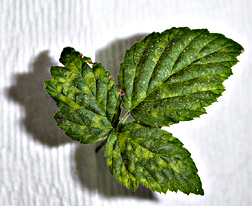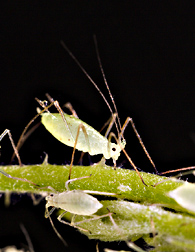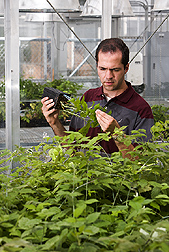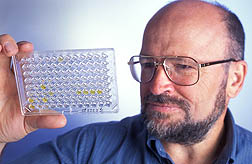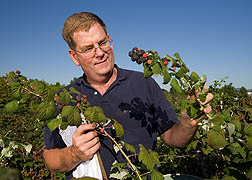Solution Sought for Black Raspberry Decline
|
|
Oregon farmers have been growing black raspberries for more than a century for making jams, beverages, desserts, and natural colorants. A source of nutritious anthocyanins, other antioxidants, and vitamin A, black raspberries have many potential health benefits.
For decades, Munger has been the cultivar of choice for the Pacific Northwest, where most of the nation’s black raspberries are grown. But growers have recently started to seek more vigorous alternatives.
“In the past, growers would plant black raspberries and harvest crops for 10 years before replacing them,” says Robert R. Martin, research leader of ARS’s Horticultural Crops Research Unit at Corvallis, Oregon. “Then in the 1990s, the plants started losing vigor. You’d be lucky to get three harvests, and many growers were replacing their plants after two.”
ARS scientists are working with farmers and industry members to identify the problem’s origin and develop control strategies.
|
|
Virus Vectors
Martin, a plant pathologist, has discovered several viruses that may contribute to the berries’ poor health. The most significant is black raspberry necrosis virus, which has been present in all observed cases. The virus can exist in isolation, Martin says. But the more severe form of decline growers have been experiencing is always accompanied by another virus: raspberry bushy dwarf, raspberry mottle, black raspberry latent––or any combination of the three.
Understanding how these diseases are transmitted and how they interact with their plant hosts is essential to controlling the problem. For example, scientists know that raspberry bushy dwarf and black raspberry latent viruses are pollen borne and have fairly mild symptoms in black raspberry. Scientists are less likely to be successful in controlling the problem by targeting the pollen-borne viruses, since preventing pollination would reduce fruit set and quality and severely affect production.
“The other two diseases are aphid transmitted, which gives us more options for an effective vector-control strategy,” Martin says.
|
|
He and his colleagues have identified the raspberry aphid as a major culprit in the spread of black raspberry necrosis virus and raspberry mottle virus. Aphids are very effective disease vectors because they can transmit a virus to a plant in a few seconds. Since aphids can spread viruses in less time than it takes pesticides to kill the aphids, spraying black raspberry fields might not be an effective prevention strategy.
One potential solution would be to surround black raspberry fields with trap plants, such as blackberries, that also appeal to raspberry aphids but are not susceptible to this severe decline. Instead of spraying the entire field, growers could simply treat the bordering plants with a low-toxicity pesticide. Those plants would act as a barrier, ensuring that the aphids are defeated before they have an opportunity to spread the virus.
Breeding Benefits
Plant geneticist Chad Finn is investigating the possibility of breeding disease- and insect-resistant black raspberry plants. Several years ago, he and his colleagues collected and assessed 16 different commercial cultivars. All were obtained from either commercial nurseries or the ARS National Clonal Germplasm Repository (NCGR) at Corvallis. They tested the plants for yield, berry size, vigor, and flowering and fruiting times. With Oregon State University graduate student Michael Dossett, they crossed among the eight most promising cultivars as well as with two selections from the wild. They examined the offspring to assess genetic variability and inheritance of various fruit and plant traits.
|
|
Dossett worked with ARS food technologist Jungmin Lee at Parma, Idaho, to evaluate the usefulness of the resulting populations as parental material for fruit chemistry traits in future breeding efforts. They measured the berries’ Brix (a measure of sweetness) and titratable acidity—qualities that can influence commercial success—as well as their phenolic and anthocyanin contents. Anthocyanins are the dark pigments that make black raspberries ideal as natural colorants, and recent studies suggest that they could have anti-degenerative and anti-inflammatory effects.
Dossett examined the results to determine which traits, such as nutritional benefits, the breeders could select for. But analysis of the initial crosses revealed a dearth of diversity—with one notable exception. A selection from the wild in North Carolina consistently produced vigorous, healthy, sturdy offspring that seemed to be less susceptible to disease than the other plants in the study. The anthocyanin makeup of these plants was also significantly different from that of the cultivars.
The results suggest that it is possible to breed black raspberries for improved characteristics, but the process could be slow and would likely benefit from introduction of wild germplasm.
|
|
Seed Search
Based on those findings, Finn, Dossett, and Kim Hummer, research leader and curator of NCGR, received grant funding to collect wild black raspberry germplasm in the eastern United States.
In June 2007, Hummer and Dossett traveled more than 2,000 miles to collect 15 accessions of black raspberries from 15 locations in South Carolina, Georgia, and Alabama. In July, Finn and Dossett traveled an additional 2,500 miles to collect 29 black raspberry accessions from locations in Kansas, Nebraska, South Dakota, and Minnesota.
“Between the two collecting trips and seed received from colleagues, we now have material from wild populations in 23 states and 2 Canadian provinces,” Dossett says.
Now the scientists are assessing the variability of the plants produced from the newly obtained seed accessions. Initial observations have revealed diversity in several characteristics, including thorniness, ripening time, and picking ease. They are comparing the diversity and characteristics within subsets of the population—for example, black raspberries obtained from Alabama—and within the entire population. This information can help breeders decide whether and where to seek more germplasm for breeding purposes.
During the initial screenings, scientists identified some resistance to the aphid vector of many of the viruses, raising hopes of developing cultivars resistant to the aphid-transmitted viruses. Ultimately, the scientists hope to breed a replacement for Munger with comparable flavor, nutritional quality, and fruit chemistry characteristics as well as superior hardiness, longevity, and aphid resistance.
In autumn of 2007 they planted the seeds they collected. Tests on those plants will reveal whether wild eastern black raspberry germplasm can be used to breed hardier plants for commercial use in Oregon or whether breeders should use another tactic, such as crossing black raspberries with red raspberries that have greater vigor.—By Laura McGinnis, Agricultural Research Service Information Staff.
This research is part of Plant Genetic Resources, Genomics, and Genetic Improvement (#301), Plant Biological and Molecular Processes (#302), Plant Diseases (#303), and Crop Production (#305), four ARS national programs described on the World Wide Web at www.nps.ars.usda.gov.
To reach scientists mentioned in this article, contact Laura McGinnis, USDA-ARS Information Staff, 5601 Sunnyside Ave., Beltsville, MD 20705-5129; phone (301) 504-1654, fax (301) 504-1486.
"Solution Sought for Black Raspberry Decline" was published in the January 2008 issue of Agricultural Research magazine.







